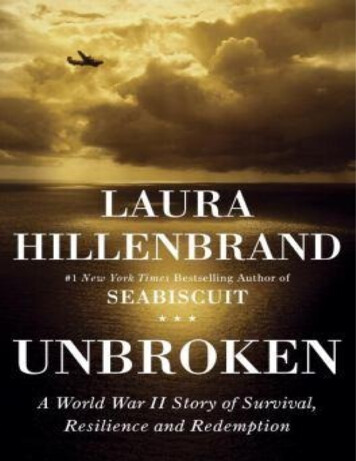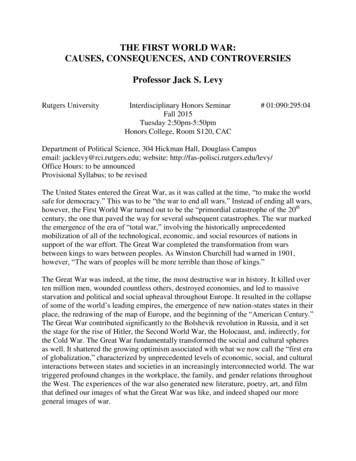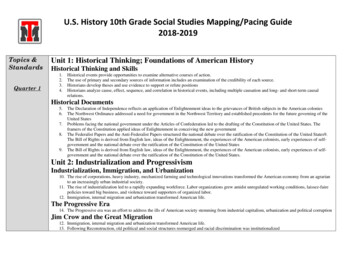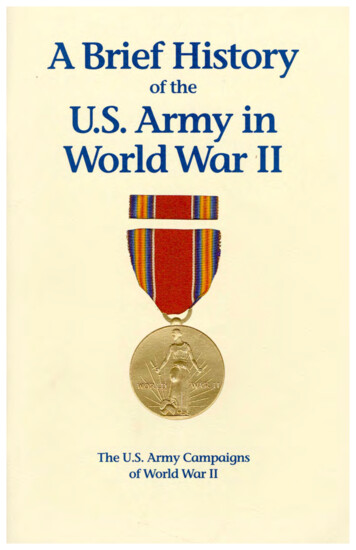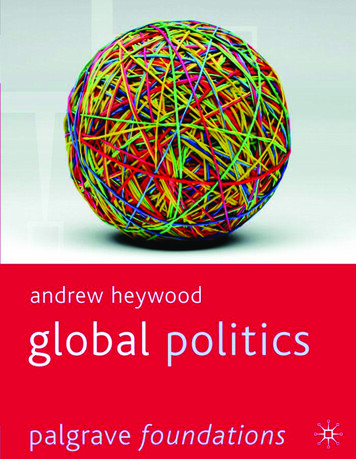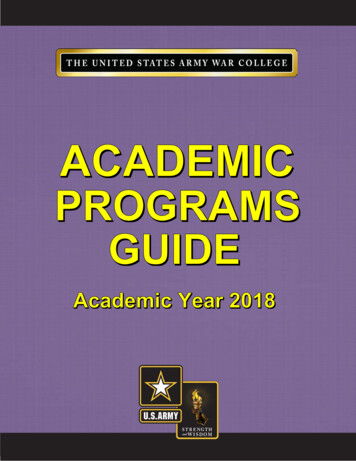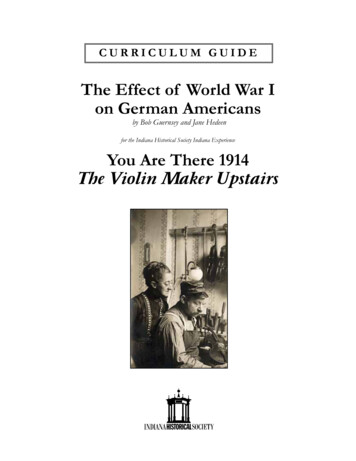
Transcription
CURRICULUM GUIDEThe Effect of World War Ion German Americansby Bob Guernsey and Jane Hedeenfor the Indiana Historical Society Indiana ExperienceYou Are There 1914The Violin Maker Upstairs
This is a publication of the Indiana Historical SocietyEugene and Marilyn Glick Indiana History Center450 West Ohio StreetIndianapolis, IN 46202-3269 USATeacher Resource available online: http://www.indianahistory.orgCover Image: “Mr. and Mrs. Joseph Conrath in the Violin Shop ” (Indiana Historicl Society, Digital Image Collections,Item ID: P0404 FOLDER1 MR AND MRS CONRATH)Copyright 2010Indiana Historical SocietyAll rights reservedExcept for copying portions of the teacher resources by educators for classroom use, or for quoting of brief passages for reviews, no part of this publication may be reproduced, stored in or introduced into a retrieval system, or transmitted, in any formor by any means (electronic, mechanical, photocopying, recording, or otherwise), without written permission of the copyrightowner. All inquiries should be addressed to the Public Programs Division, Indiana Historical Society.
IntroductionThis lesson coordinates with the You Are There1914: The Violin Maker Upstairs component of theIndiana Experience at the Eugene and Marilyn GlickIndiana History Center in Indianapolis. In thisexperience, visitors are invited to step back in timeto 1914 to visit the re-created workshop of stringedinstrument maker Joseph Conrath. In his shop,located at 39 Virginia Avenue in Indianapolis,Conrath repaired and crafted stringed instruments,such as violins, violas, guitars, mandolins, banjoes,and cellos. As a luthier, or stringed instrumentmaker, Conrath served the many musicians whoparticipated in Indianapolis’s vibrant cultural sceneof the early 1900s. New instruments and instrumentrepair were in demand due to the number of orchestras and musical societies that called Indianapolishome at the time. Though Conrath could not playany of the instruments he made, his skills as a carpenter and singer helped him produce instrumentsthat looked and sounded beautiful.Conrath was born in Cincinnati, Ohio, to immigrantparents. His mother was German and his fathercame from Alsace-Lorraine, a region that had passedbetween Germany and France for many years. In1914 Alsace-Lorraine was once again a battlegroundbetween French and German soldiers. The Conrathfamily moved to Indianapolis around 1887 and onJune 11, 1896, Conrath married Amelia Bush, whosefamily was also German. Being a part of the city’slarge German American population, the Conrathsmight have participated in German cultural societies,such as the Turnverein (a gymnastics and culturalsociety) or the Mannerchor (a music society). Theymay have read German-language newspapers or attended one of the city’s German churches.As Hoosiers with close ties to Germany, the Conraths and other German Americans kept tabs on theevents in Europe. World War I erupted in Europeafter the June 28, 1914, assassination by a Serbiannationalist of Archduke Franz Ferdinand, heir tothe Austro-Hungarian Empire. Germany, an allyof Austria-Hungary, declared war on Serbia and itsallies. President Woodrow Wilson kept Americaout of the war until April 1917, when the UnitedStates joined the Allied powers of Serbia, Russia,France, and Great Britain in declaring war on theCentral powers of Germany and Austria-Hungary.Leading up to and after America’s entry into thewar, there was growing anti-German sentiment inthe United States.This curriculum is intended to provide historicalcontext for German American life and culture inIndianapolis in the 1910s. The materials may be usedto prepare students for a visit to You Are There1914: The Violin Maker Upstairs or as a follow-uplesson. The historical context and themes arerelevant to classroom instruction even if a HistoryCenter visit is not possible. The You Are There1914: The Violin Maker Upstairs experience willremain open through September 3, 2011.Overview/DescriptionIn this lesson students will analyze World War I-erapropaganda posters and consider how GermanAmericans would have reacted to them during thattime. Students will also reflect on cultural bias and itseffect on ethnic groups in the United States.Grade LevelHigh SchoolAcademic Standards for the Social Studies Indiana Standards (as of March 2010) High School, U.S. History, Standard 3,Emergence of the Modern United States:1897 to 1920, USH 3.2.1––Identify theevents and people central to the transformation of the United States into a worldpower, and Standard 9, Historical Thinking, USH.9.2––Locate and analyze primary sources and secondary sources relatedto an event or issue of the past. High School, Sociology, Standard 4,Social Groups, S 4.10––Distinguishthe degree of assimilation that ethnic,cultural, and social groups achieve withinthe United States.1 CURRICULUM GUIDE Indiana Experience The Effect of World War I on German Americans Indiana Historical Society
National StandardsNational Council for the Social Studies, Curriculum Standards for Social Studies (Washington D.C.:National Coucil for the Social Studies, 1994) I Culture Predict how data and experiencesmay be interpreted by people from diverse cultural perspectives and framesof reference. VI Power, Authority, and Governance Analyze and explain ideas and mechanisms to meet needs and wants ofcitizens, regulate territory, manageconflict, establish order and security,and balance competing conceptionsof a just society.Evaluate the role of technology incommunications, transportation,information processing, weaponsdevelopment, or other areas as it contributes to or helps resolve conflicts.Evaluate the extent to which governments achieve their stated ideals andpolicies at home and abroad.Social Studies/Historical ConceptsWorld War I and propagandaLearning/Instructional ObjectivesStudents will: Analyze and interpret World War Ipropaganda posters. Identify the effects that propaganda materials had on people of difference ethnicbackgrounds, especially German Americans,during World War I.Time RequiredTwo class periods of fifty minutes each.Materials Required Paper Pencil, pens, and markers Newsprint or posterboard World War I posters from the Indiana Historical Society Digital Image Collections orother source. Copies of posters from the IHScollection are provided on pages six througheleven of this lesson. “Halt the Hun Buy U.S. GovernmentBonds, Third Liberty Loan”(Indiana Historical Society Digital ImageCollections, Item ID: P0131 FF2C-9THIRD LIBERTY LOANS) “Hun or Home -- Buy More LibertyBonds” (Indiana Historical SocietyDigital Image Collections, Item ID:P0131 FF2C-F10 HUN OR HOME) “Must Children Die and Mothers Pleadin Vain? Buy More Liberty Bonds”(Indiana Historical Society Digital ImageCollections, Item ID: P0131 FF21C-F12BUY MORE LIBERTY BONDS) “Remember Belgium Buy Bonds FourthLiberty Loan” (Indiana Historical SocietyDigital Image Collections, Item ID: P0131FF2C-14 REMEMBER BELGIUM) “The Hun-His Mark-- Blot it Out withLiberty Bonds” (Indiana Historical Society Digital Image Collections, Item ID:P0131 FF21E-F19 BLOT IT OUT) “The Snake - Every Liberty Bond Boughtby You Helps Uncle Sam Uncover the Reptile Which is Hiding Under Old Gloryin Our Own Front Yard. God Pity theSPIES, the TRAITORS, the PROFITEERS,the SLACKERS, the SNAKES, Who areFilling their Pockets with American Gold atthe Cost of American Blood—“WOE BEUNTO YOU!” BUY LIBERTY BONDS”2 CURRICULUM GUIDE Indiana Experience The Effect of World War I on German Americans Indiana Historical Society
(Indiana Historical Society Digital ImageCollections, Item ID: P0131 FF2D-F20SNAJE LIBERTY LOANS) “Poster Analysis Worksheet” Designed and developed by the EducationStaff, National Archives and RecordsAdministration, Washington, D.C.Accessed December 1, 2010, at ts/poster.html.Background/Historical ContextWorld War I was a pivotal time for people ofGerman heritage in America. When a Serbiannationalist assassinated Archduke Franz Ferdinand,the heir to the Austro-Hungarian throne, in Sarajevoon June 28, 1914, a system of alliances amongEuropean nations was set into motion, eventuallyresulting in war. One month later, Austria-Hungarydeclared war on Serbia. Germany and Turkeyjoined Austria-Hungary, fulfilling their allianceagreements. Russia, France, and Great Britain, inturn, joined Serbia in its fight.Germany came into the war having been unitedin 1871. According to historian Bernd Huppauf,Germany was a latecomer on the European scene:“The world had been carved up before they had arrived. The world in terms of the colonies, the worldin terms of power politics had been finalized, andthe Germans came late. Yet, they felt they deserveda position within this world, according to their selfesteem, according to their size, according to theirgrandiose history leading back into the Middle Ages.There was the fear that with German unification,the power structure had changed to a degree, thatnow war had to be waged. That war had becomeinevitable.”1 It appeared that Germany felt it hadsomething to prove and as a result was seen as anaggressor nation.1. Public Broadcasting Service, “Germany Beforethe War,” by Bernd Huppauf, in The Great Warand the Shaping of the 20th Century, accessedNovember 9, 2009, http://www.pbs.org/greatwar/historian/hist huppauf 01 before.html.President Woodrow Wilson quickly proclaimedAmerica to be neutral in the conflict, a decisionsupported by the vast majority of Americans. ForGerman Americans, however, the war evoked strongfeelings. “With the outbreak of war, many local German Americans rallied to support their homeland,”according to one study by the POLIS Center.2 TheIndiana German American Alliance, led by businessman Joseph H. Keller, supported the German causeby lobbying Congress against unfavorable actionstoward Germany.3 In addition, the GermanisticSociety of Indianapolis encouraged the study ofGerman society and culture beginning in 1916.4 Thisdisplay of German patriotism exacerbated an existing cultural division between Germans and “nativist”or anti-immigrant Americans.As the war proceeded and Germany attemptedto blockade the British Isles, American opinionturned against the Germans. As the United Stateswas one of Britain’s biggest trading partners, itsships were in danger as they attempted to crossthe Atlantic Ocean. American neutrality endedafter German mines and submarines damaged orsunk several U.S. ships traveling to Great Britain.By the time the United States entered the war in1918, anti-German sentiment was prevalent,making the environment uncomfortable for GermanAmericans in Indianapolis and throughout the country.“As the war progressed, the local German Americanpopulation and their institutions became targets ofverbal and physical attacks. Civil service reformerLucius Swift spoke out strongly against Germanaggression. Local women’s groups used the Germanargument to support their temperance activitiesin opposition to German beer gardens,” notedthe POLIS Center.5 In January 1918, the Indianapolis Board of School Commissioners passed a resolution declaring that public schools “should not assist2. Polis Center, Indiana University PurdueUniversity Indianapolis, “World War I, 1914–1920,”in Religion and American Community, accessedSeptember 25, 2009, napolis.asp.3. Ibid.4. Ibid.5. Ibid.3 CURRICULUM GUIDE Indiana Experience The Effect of World War I on German Americans Indiana Historical Society
in perpetuating the language of an alien enemy inour homes and enemy viewpoints in the community,” effectively ending German-language instruction in the city.6 As a result of this persecution,Indianapolis German Americans tried to blendin with their neighbors by Americanizing theirsurnames, street names, and the names of someof their vereins (clubs). For example, the Germancultural center, Das Deutsche Haus, became theAthenaeum; German churches stopped givingsermons in German; German newspapers ceasedpublication; and schools stopped teaching theGerman language.Widespread anti-German propaganda encouragedpersecution of Americans with a German heritage. U.S. government-produced movies, posters,and literature demonized Germans and characterized them as evil and subhuman. Propaganda,information spread for the purpose of furtheringa cause, often promotes fear, distrust, and angertowards an individual or group labeled as theenemy. In wartime, propaganda promotes supportfor an action or movement against the enemy andis a common tool used to garner support for thegovernment and its military forces.During World War I, German Americans who mayhave felt threatened by growing anti-German sentiment chose to display their patriotism in severalways. By changing their name, discontinuing the useof their native language outside their homes,altering instruction and services offered in schoolsand community organizations, or in other ways, German Americans may have lost a part of their ethnicidentity as well.Teacher’s Instructional ObjectiveIntroductionIn this lesson students will study six posters fromthe Indiana Historical Society collection that illustrate World War I-era propaganda. Studentswill complete a student handout for each of theposters and then meet as a class to discuss theiranswers and interpretations of the posters.If this lesson is introduced early in the study ofWorld War I, explain to students that the war wasoften perceived in the United States as a Europeanwar and Americans were reluctant to get involved.Both the Allies (Britain, France, Belgium, Russia,and others) and the Central powers (the GermanEmpire, the Austro-Hungarian Empire, theOttoman Empire, and Bulgaria) tried desperately togain support from the United States. Propagandawas used by both sides in an attempt to sway publicopinion and gain the support of the U.S. government. As the posters used in this lesson show, theAllies successfully used propaganda to portrayGermany as a brutal aggressor.ActivityProcedure Conduct a brief class discussion to definepropaganda and gather student ideas andexamples of what propaganda materialsmight say. Questions to ask students mightinclude: What would a wartime message say?What point of view would it reflect? Who isthe intended audience? Who is the messageintended to attack? Write student examples onthe board. Place color copies of the propaganda posters atdifferent locations around the room so that eachwork area has a complete set of the posters. Divide the class into small groups (the numberand group size will depend on overall class size)and provide each student with six copies ofthe “Poster Analysis Worksheet,” one for eachposter to be reviewed. Explain to the students that they will be looking at propaganda posters from World War I.Their assignment is to read the instructionson the handout and respond to the questions.Allow students time to review each poster andrespond to questions on the handout.6. Ibid.4 CURRICULUM GUIDE Indiana Experience The Effect of World War I on German Americans Indiana Historical Society
After students have completed the poster analysis, facilitate a class discussion of their observations. Consider asking the following questions:What examples of propaganda do you see?How do you feel looking at the poster(s)? Doesit make you feel one side is good and the otheris bad? What do you think German Americanswould feel if they saw these posters? What doyou think they did? How do you think otherAmericans might treat German Americans?What might happen? Students should use reasonand logic to support their answer.Bring in a recent newspaper and ask students toreview it to identify examples of propaganda,such as advertisements, editorial cartoons, headlines, and editorial pages. To conclude the activity, distribute newsprint,pencils, pens, and markers to each group. Explain that they are to create a propaganda posterto persuade the American public to support aparticular topic. (Teachers may select a specifictopic or if this is an individual student assignment, have student topics approved by theteacher in advance.)Web Sites Have students display their work and, as timepermits, make brief presentations to the class.Library of Congress. “World War I Posters.” Accessed December 1, 2010. luation and AssessmentAt the conclusion of the lesson, students should recognize that propaganda is used to sway opinion andthe information presented is not necessarily accurate.It is also used to make people behave in a specificway. These facts should appear to some degree instudent responses, either in writing assignments, inclass discussions, or in their poster design.Suggested ModificationsAsk students to review magazines, newspapers,television, and Web sites to find contemporaryexamples of propaganda materials. Teachers maywant to select a few examples for class discussion.Conduct a student debate to consider if advertisements are a form of propaganda and if they areaccurate representations of the products, services,issues, or causes they are promoting.Additional ResourcesPublicationsHoyt, Giles R. “Germans.” In Peopling Indiana:The Ethnic Experience. Robert M. Taylor Jr.and Connie A. McBirney, eds. 1996. Reprint,Indianapolis: Indiana Historical Society, 2009.Firstworldwar.com/. A Multimedia History ofWorld War One. “Propaganda Posters-Introduction.” Accessed December 1, 2010. http://www.firstworldwar.com/posters/index.htm.A commercial site that provides links toWorld War I propaganda posters.The Library of Congress makes availableonline approximately 1,900 posters createdbetween 1914 and 1920.UNC School of Education, Learn NCMultimedia: K–12 Teaching and Learning.“World War I, Propaganda Posters.”Accessed December 1, 2010. http://www.learnnc.org/editions/ww1posters.An excellent site providing examples ofWorld War I propaganda posters.World War I: Trenches on the Web.“USA Great War Poster Reproductions.”Accessed December 1, 2010. http://www.worldwar1.com/rep0002.html.This commercial site has several examplesof World War I propaganda posters.5 CURRICULUM GUIDE Indiana Experience The Effect of World War I on German Americans Indiana Historical Society
“Halt the Hun Buy U.S. Government Bonds, Third Liberty Loan” (Indiana Historical SocietyDigital Image Collections, Item ID: P0131 FF2C-9 THIRD LIBERTY LOANS)6 CURRICULUM GUIDE Indiana Experience The Effect of World War I on German Americans Indiana Historical Society
“Hun or Home -- Buy More Liberty Bonds” (Indiana Historical Society Digital Image Collections,Item ID: P0131 FF2C-F10 HUN OR HOME)7 CURRICULUM GUIDE Indiana Experience The Effect of World War I on German Americans Indiana Historical Society
“Must Children Die and Mothers Plead in Vain? Buy More Liberty Bonds” (Indiana Historical SocietyDigital Image Collections, Item ID: P0131 FF21C-F12 BUY MORE LIBERTY BONDS)8 CURRICULUM GUIDE Indiana Experience The Effect of World War I on German Americans Indiana Historical Society
“Remember Belgium Buy Bonds Fourth Liberty Loan” )Indiana Historical Society Digital Image Collections, Item ID: P0131 FF2C-14 REMEMBER BELGIUM)9 CURRICULUM GUIDE Indiana Experience The Effect of World War I on German Americans Indiana Historical Society
“The Hun-His Mark-- Blot it Out with Liberty Bonds” (Indiana Historical Society Digital Image Collections, Item ID: P0131 FF21E-F19 BLOT IT OUT)10 CURRICULUM GUIDE Indiana Experience The Effect of World War I on German Americans Indiana Historical Society
“The Snake - Every Liberty Bond Bought by You Helps Uncle Sam Uncover the Reptile Which is Hiding UnderOld Glory in Our Own Front Yard. God Pity the SPIES, the TRAITORS, the PROFITEERS, the SLACKERS,the SNAKES, Who are Filling their Pockets with American Gold at the Cost of American Blood—“WOE BEUNTO YOU!” BUY LIBERTY BONDS” (Indiana Historical Society Digital Image Collections, Item ID:P0131 FF2D-F20 SNAJE LIBERTY LOANS)11 CURRICULUM GUIDE Indiana Experience The Effect of World War I on German Americans Indiana Historical Society
This curriculum is intended to provide historical context for German American life and culture in Indianapolis in the 1910s. The materials may be used to prepare students for a visit to You Are There 1914: The Violin Maker Upstairs or as a follow-up lesson. The historical context and theme



